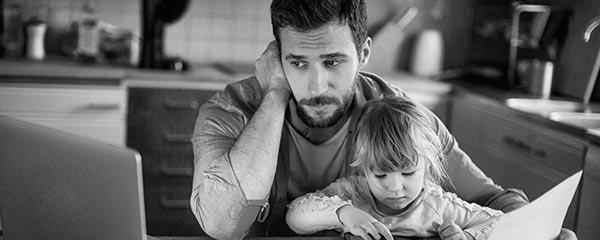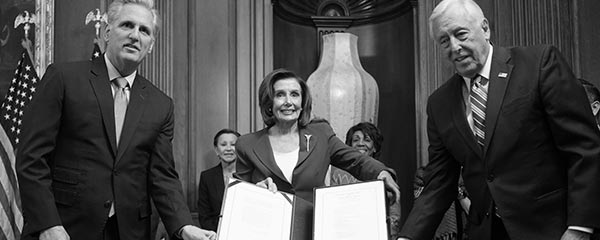Story Highlights
- Nearly nine in 10 not ready to resume normal daily activities
- Most would also wait and see before resuming normalcy upon government OK
- Half feel at risk for severe symptoms; few very confident they can prevent infection
WASHINGTON, D.C. -- If being out in public were entirely up to them at this moment during the global pandemic, 14% of Americans say they would resume their normal day-to-day activities right now, but the rest would hold off:
- 42% would wait until the number of new cases of COVID-19 declines significantly
- 38% would wait until there are no new cases for some period of time
- 7% would wait until a vaccine is developed
These findings are from an online probability-based Gallup Panel survey conducted March 27-29.
Most Would Delay Normalcy Even After Government Lifts Orders
Currently, most Americans are not free to decide about interacting in public, as they are living under state-ordered restrictions to limit their personal contact with others. Gallup also asked Americans to consider their willingness to return to normal once such government restrictions are formally lifted.
Even on this basis, about one in five (22%) say they would resume their normal daily activities "immediately." Seven in 10 would "wait to see what happens with the spread of the virus before resuming," and 9% would continue to limit their social contact "indefinitely."
Some of Americans' reluctance to go back to normal can be explained by their fear that they, themselves, would be at risk of experiencing severe COVID-19 symptoms. Nearly half say it is "very likely" (11%) or "likely" (37%) that they would face this risk.
Importantly, there is a strong correlation between Americans' estimate of their personal risk and their readiness to return to normal.
- Among those who say it's "very likely" they would suffer severe symptoms, 71% say they would continue to practice social distancing (even if there were no government restrictions) until there are no new cases or a vaccine is developed.
- Among those who say it's "likely" they'd experience severe symptoms, that percentage drops to 50%. For those who consider their chances of being very sick "unlikely," it falls to 36% -- and to 22% among those who describe their chances of severe illness as "very unlikely."
- By contrast, 44% of those who think it's very unlikely that they would experience severe symptoms say they would return to their normal activities right now.
| Very unlikely | Unlikely | Likely | Very likely | ||||||||||||||||||||||||||||||||||||||||||||||||||||||||||||||||||||||||||||||||||||||||||||||||
|---|---|---|---|---|---|---|---|---|---|---|---|---|---|---|---|---|---|---|---|---|---|---|---|---|---|---|---|---|---|---|---|---|---|---|---|---|---|---|---|---|---|---|---|---|---|---|---|---|---|---|---|---|---|---|---|---|---|---|---|---|---|---|---|---|---|---|---|---|---|---|---|---|---|---|---|---|---|---|---|---|---|---|---|---|---|---|---|---|---|---|---|---|---|---|---|---|---|---|---|
| % | % | % | % | ||||||||||||||||||||||||||||||||||||||||||||||||||||||||||||||||||||||||||||||||||||||||||||||||
| Right now | 44 | 15 | 8 | 9 | |||||||||||||||||||||||||||||||||||||||||||||||||||||||||||||||||||||||||||||||||||||||||||||||
| After the number of new cases declines significantly | 34 | 49 | 42 | 20 | |||||||||||||||||||||||||||||||||||||||||||||||||||||||||||||||||||||||||||||||||||||||||||||||
| After there are no new cases for a period of time | 17 | 32 | 42 | 58 | |||||||||||||||||||||||||||||||||||||||||||||||||||||||||||||||||||||||||||||||||||||||||||||||
| After a coronavirus vaccine is developed | 5 | 4 | 8 | 13 | |||||||||||||||||||||||||||||||||||||||||||||||||||||||||||||||||||||||||||||||||||||||||||||||
| "Return to normal activities" question wording: If there were no government restrictions and people were able to decide for themselves about being out in public, how soon would you return to your normal day-to-day activities? "Likelihood of severe symptoms" question wording: If you were infected by the coronavirus, how likely do you think it is that you would get severe symptoms? | |||||||||||||||||||||||||||||||||||||||||||||||||||||||||||||||||||||||||||||||||||||||||||||||||||
| Gallup Panel, March 27-29, 2020 | |||||||||||||||||||||||||||||||||||||||||||||||||||||||||||||||||||||||||||||||||||||||||||||||||||
Another factor that could influence Americans' comfort level in resuming normal public outings for the foreseeable future is their sense of control over being infected. The public has been advised that they can do this by maintaining a six-foot distance from others, refraining from touching their face, regularly washing their hands, and other means. The majority of Americans feel "very confident" (10%) or "somewhat confident" (54%) that they can protect themselves from COVID-19 when out in public, while over a third say they are "not too confident" (30%) or "not confident at all" (6%).
Among Americans who are very or somewhat confident about being able to shield themselves, the majority would be willing to resume their normal activities, if there were no government restrictions, either "right now" or "after the number of new cases declines significantly." By contrast, the majority of those who are not confident in their ability to protect themselves would wait until all new cases have ceased or a vaccine is ready.
| Very confident | Somewhat confident | Not too confident | Not confident at all | ||||||||||||||||||||||||||||||||||||||||||||||||||||||||||||||||||||||||||||||||||||||||||||||||
|---|---|---|---|---|---|---|---|---|---|---|---|---|---|---|---|---|---|---|---|---|---|---|---|---|---|---|---|---|---|---|---|---|---|---|---|---|---|---|---|---|---|---|---|---|---|---|---|---|---|---|---|---|---|---|---|---|---|---|---|---|---|---|---|---|---|---|---|---|---|---|---|---|---|---|---|---|---|---|---|---|---|---|---|---|---|---|---|---|---|---|---|---|---|---|---|---|---|---|---|
| % | % | % | % | ||||||||||||||||||||||||||||||||||||||||||||||||||||||||||||||||||||||||||||||||||||||||||||||||
| Right now | 29 | 15 | 7 | 9 | |||||||||||||||||||||||||||||||||||||||||||||||||||||||||||||||||||||||||||||||||||||||||||||||
| After the number of new cases declines significantly | 39 | 45 | 39 | 38 | |||||||||||||||||||||||||||||||||||||||||||||||||||||||||||||||||||||||||||||||||||||||||||||||
| After there are no new cases for a period of time | 26 | 35 | 45 | 42 | |||||||||||||||||||||||||||||||||||||||||||||||||||||||||||||||||||||||||||||||||||||||||||||||
| After a coronavirus vaccine is developed | 6 | 5 | 10 | 11 | |||||||||||||||||||||||||||||||||||||||||||||||||||||||||||||||||||||||||||||||||||||||||||||||
| "Return to normal activities" question wording: If there were no government restrictions and people were able to decide for themselves about being out in public, how soon would you return to your normal day-to-day activities? "Confidence in protect yourself" question wording: How confident are you that you can protect yourself when out in public from being infected by the coronavirus? | |||||||||||||||||||||||||||||||||||||||||||||||||||||||||||||||||||||||||||||||||||||||||||||||||||
| Gallup Panel, March 27-29, 2020 | |||||||||||||||||||||||||||||||||||||||||||||||||||||||||||||||||||||||||||||||||||||||||||||||||||
Demographic Differences in Reluctance to Normalize
A slight majority of Democrats (56%), residents of the Northeast (53%) and adults who are not employed (51%) indicate they would wait until there are no new cases or until a vaccine is developed before returning to normal daily life. By contrast, the majority of Republicans (69%), independents (59%) and employed adults (60%) are willing to return to normal sooner.
| Right now | After new cases decline significantly | After no new cases for a period of time | After vaccine is developed | ||||||||||||||||||||||||||||||||||||||||||||||||||||||||||||||||||||||||||||||||||||||||||||||||
|---|---|---|---|---|---|---|---|---|---|---|---|---|---|---|---|---|---|---|---|---|---|---|---|---|---|---|---|---|---|---|---|---|---|---|---|---|---|---|---|---|---|---|---|---|---|---|---|---|---|---|---|---|---|---|---|---|---|---|---|---|---|---|---|---|---|---|---|---|---|---|---|---|---|---|---|---|---|---|---|---|---|---|---|---|---|---|---|---|---|---|---|---|---|---|---|---|---|---|---|
| % | % | % | % | ||||||||||||||||||||||||||||||||||||||||||||||||||||||||||||||||||||||||||||||||||||||||||||||||
| U.S. adults | 14 | 42 | 38 | 7 | |||||||||||||||||||||||||||||||||||||||||||||||||||||||||||||||||||||||||||||||||||||||||||||||
| Men | 19 | 42 | 31 | 8 | |||||||||||||||||||||||||||||||||||||||||||||||||||||||||||||||||||||||||||||||||||||||||||||||
| Women | 9 | 42 | 44 | 5 | |||||||||||||||||||||||||||||||||||||||||||||||||||||||||||||||||||||||||||||||||||||||||||||||
| 18-29 years old | 20 | 33 | 40 | 7 | |||||||||||||||||||||||||||||||||||||||||||||||||||||||||||||||||||||||||||||||||||||||||||||||
| 30-49 years old | 13 | 48 | 32 | 7 | |||||||||||||||||||||||||||||||||||||||||||||||||||||||||||||||||||||||||||||||||||||||||||||||
| 50-64 years old | 16 | 38 | 40 | 7 | |||||||||||||||||||||||||||||||||||||||||||||||||||||||||||||||||||||||||||||||||||||||||||||||
| 65 and older | 10 | 41 | 45 | 5 | |||||||||||||||||||||||||||||||||||||||||||||||||||||||||||||||||||||||||||||||||||||||||||||||
| College graduate | 7 | 50 | 37 | 6 | |||||||||||||||||||||||||||||||||||||||||||||||||||||||||||||||||||||||||||||||||||||||||||||||
| Not college graduate | 17 | 39 | 38 | 6 | |||||||||||||||||||||||||||||||||||||||||||||||||||||||||||||||||||||||||||||||||||||||||||||||
| Democrat | 5 | 39 | 50 | 6 | |||||||||||||||||||||||||||||||||||||||||||||||||||||||||||||||||||||||||||||||||||||||||||||||
| Independent/Other | 18 | 41 | 30 | 11 | |||||||||||||||||||||||||||||||||||||||||||||||||||||||||||||||||||||||||||||||||||||||||||||||
| Republican | 22 | 47 | 28 | 3 | |||||||||||||||||||||||||||||||||||||||||||||||||||||||||||||||||||||||||||||||||||||||||||||||
| City | 13 | 46 | 36 | 4 | |||||||||||||||||||||||||||||||||||||||||||||||||||||||||||||||||||||||||||||||||||||||||||||||
| Suburb | 11 | 41 | 40 | 7 | |||||||||||||||||||||||||||||||||||||||||||||||||||||||||||||||||||||||||||||||||||||||||||||||
| Small town/Rural | 16 | 41 | 36 | 7 | |||||||||||||||||||||||||||||||||||||||||||||||||||||||||||||||||||||||||||||||||||||||||||||||
| Northeast | 9 | 39 | 48 | 5 | |||||||||||||||||||||||||||||||||||||||||||||||||||||||||||||||||||||||||||||||||||||||||||||||
| Midwest | 14 | 44 | 37 | 5 | |||||||||||||||||||||||||||||||||||||||||||||||||||||||||||||||||||||||||||||||||||||||||||||||
| South | 15 | 42 | 36 | 7 | |||||||||||||||||||||||||||||||||||||||||||||||||||||||||||||||||||||||||||||||||||||||||||||||
| West | 15 | 44 | 33 | 8 | |||||||||||||||||||||||||||||||||||||||||||||||||||||||||||||||||||||||||||||||||||||||||||||||
| Employed | 15 | 45 | 34 | 5 | |||||||||||||||||||||||||||||||||||||||||||||||||||||||||||||||||||||||||||||||||||||||||||||||
| Not employed | 11 | 38 | 43 | 8 | |||||||||||||||||||||||||||||||||||||||||||||||||||||||||||||||||||||||||||||||||||||||||||||||
| Gallup Panel, March 27-29, 2020 | |||||||||||||||||||||||||||||||||||||||||||||||||||||||||||||||||||||||||||||||||||||||||||||||||||
View complete question responses and trends (PDF download).
Learn more about how the Gallup Panel works.




